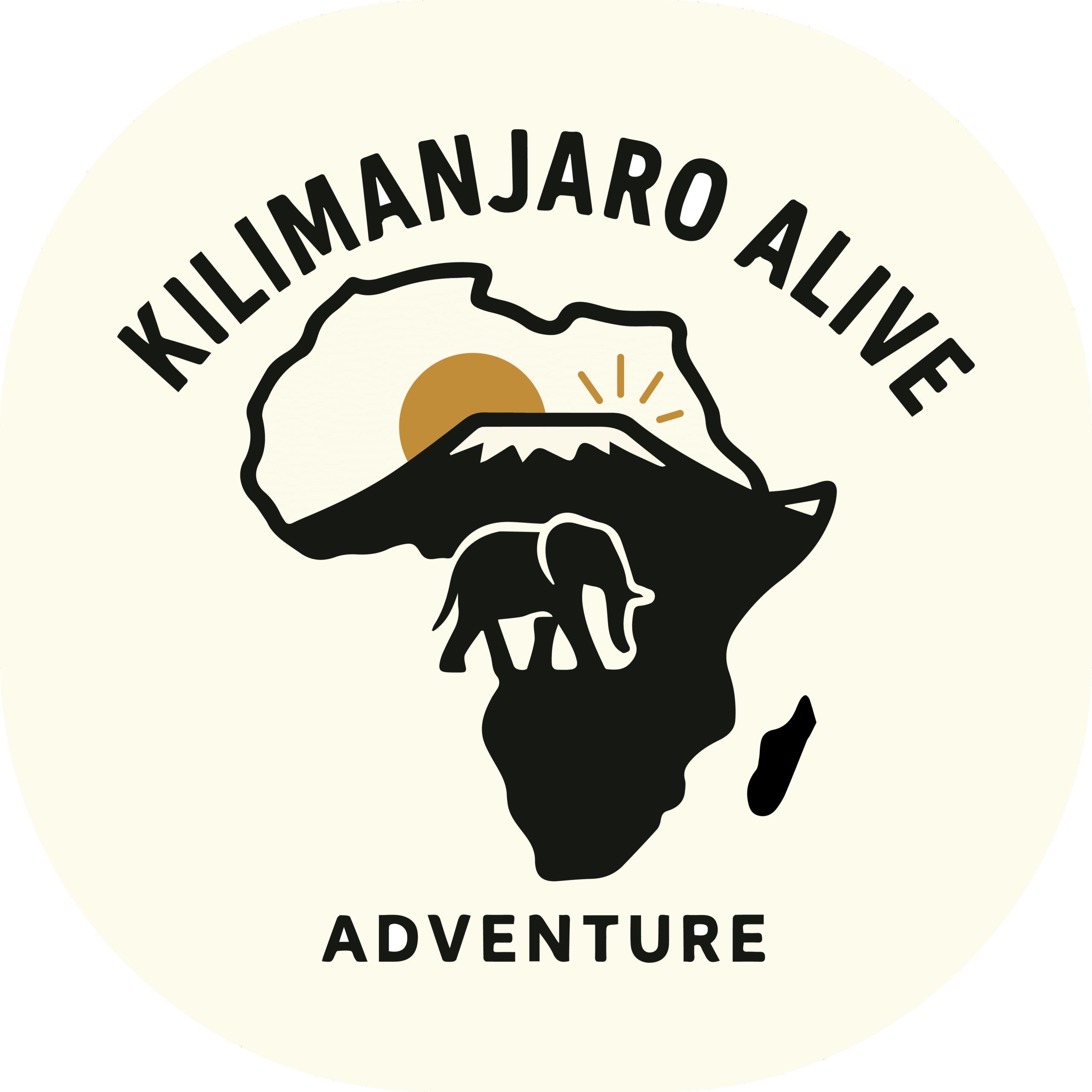UMBWE ROUTE (6 DAYS)
Umbwe route is a challenging route of Mount Kilimanjaro with the fast ascend to high altitude. The route does not provide necessary acclimatization’s .it is very difficult to success in hiking Kilimanjaro mountain-the roof of Africa. This route needs strong hikers who are quickly acclimatize to altitude. It is located in southern part of Kilimanjaro Mountain, it is short, steeper and direct climb. Mweka route is used as descending route from the top of Mount Kilimanjaro (Uhuru peak 5895)
Description
Day 0 | Arrival in Tanzania
Welcome to Tanzania! Upon your arrival at Kilimanjaro International Airport, you will be greeted by a representative from Kilimanjaro Alive adventure who will transfer you to your hotel in Moshi. After check-in, you can relax, explore the town, and prepare for your exciting journey ahead. In the evening, you will attend a pre-climb briefing with your guide who will provide you with important information about the climb.
Day 1 | Umbwe Gate to Umbwe Camp
Elevation (ft): 5,249 ft to 9,514 ft
Distance: 11 km
Hiking Time: 5-7 hours
Habitat: Rain Forest
After wake up you will have a breakfast early in the morning, mountain guides they will pick you from the hotel and transferring you to Umbwe gate where you will finish up registration and issuing the permit for hiking Mount Kilimanjaro with all necessary summit gears. You will start ascending to Umbwe camp via dense forest on a steeper slope and mud path. There you can get lunch, dinner and resting overnight.
Day 2 | Umbwe Camp to Barranco Camp
Elevation (ft): 9,514 ft to 13,044 ft
Distance: 6 km
Hiking Time: 4-5 hours
Habitat: Heath
After wake up you will have breakfast early in the morning then you will start ascending with tour guides into the heath zone where you will experience quickly changes to sparse vegetation’s, rocky outcrops and giant heathers. Then you will continue climb to Barranco valley, between with there is narrow ridge. Barrancovalley offer great view of Kibo peak and Moshi town, you will take a lunch, dinner and resting overnight.
Day 3 | Barranco Camp to Karanga Camp
Elevation (ft): 13,044 ft to 13,106 ft
Distance: 5 km
Hiking Time: 4-5 hours
Habitat: Alpine Desert
After wake up at Barranco camp you will have breakfast then you will continue climb the amazing volcanic rock of about 1200ft barranco wall. After reaching upward you will enjoy ore fantastic view of barafu and Mountain meru. Then you will continue pass cross ridge and valley to Karanga valley camp site. It will be short day for acclimatization.
Day 4 | Karanga Camp to Barafu Camp
Elevation (ft): 13,106 ft to 15,331 ft
Distance: 4 km
Hiking Time: 4-5 hours
Habitat: Alpine Desert
After wake up at Karanga campsite you will have breakfast you leave Karangacamp site and hit the junction which connect the Mweka Trail and continue hiking up to Barafu campsite where you can have lunch, dinner, resting , also this cite offer good views of difference angles . at this point you real need to prepare yourself for summiting at Uhuru peak through preparing necessary requirements like warm clothes to protect yu from coldest condition, wind break clothes due to strong wind, head touch because hiking start during the mid-night.
Day 5 | Barafu Camp to Uhuru Point to Mweka Hut
Elevation (ft): 15,331 ft to 19,341 ft to 10,065 ft
Distance: 17 km
Hiking Time: 11-14 hours
Habitat: Arctic
During a mid-night you will be awaked with our professional mountain guides and get ready for summit, you will head in the northern west direction and ascending through heavy screw towards Stella point on the crater rim. At Stella point you will stop for few minutes for resting and continue hiking to Uhuru peak. At Uhuru peak you will spend short time for taking photos, good views and wonderfully observation of different parts of Africa continent. There after you will start descending from Uhuru peak vie Mweka route to Mweka hut campsite
Day 6 | Mweka Camp to Moshi
Elevation (ft): 10,065 ft to 5,380 ft
Distance: 10 km
Hiking Time: 3-4 hours
Habitat: Rain Forest
After breakfast you will continue descending down to Mweka gate to receive your summit cirticificate. You will experience change of elevation with wet and muddy, due to this situation hiking stick will help to make you stable our travel agency will travel you from Mweka gate back to the best hotel in Moshi for enjoyable meals, resting and overnight.
Day of departure: Transfer to the Kilimanjaro Airport.
This package includes the following :
This package does not include the following :
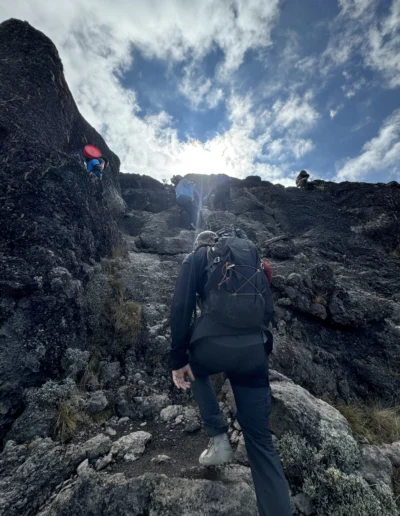
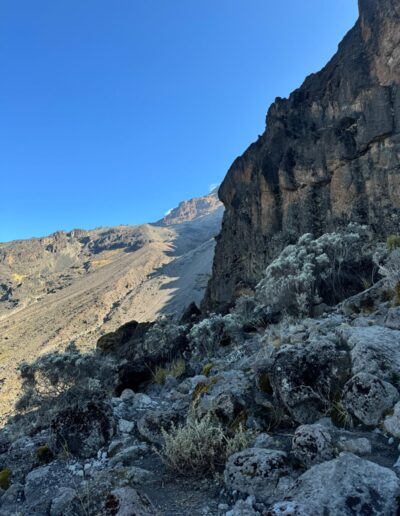
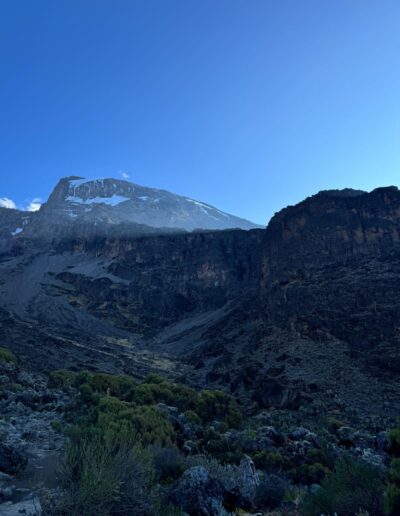
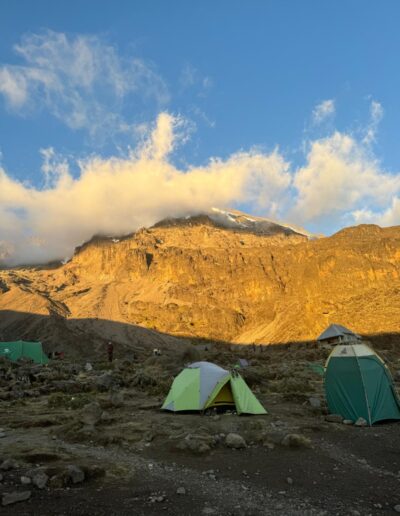
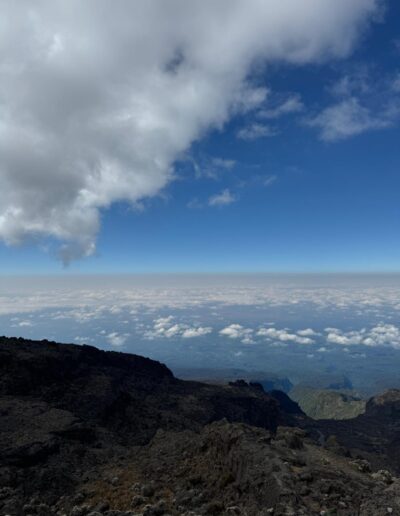
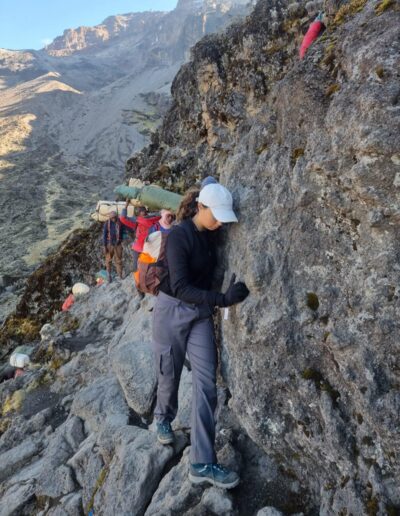
Frequently Asked Questions: Climbing Mount Kilimanjaro
Before You Go: Preparation & Conditions
How hard is it to climb Mount Kilimanjaro?
Climbing Mount Kilimanjaro is challenging but achievable with the right preparation. It is a non-technical climb, meaning no special equipment is needed, but the altitude and physical endurance required can make it tough. With proper acclimatization, physical fitness, and support from experienced guides, most people in good health can reach the summit.
What is the best time of year to climb Kilimanjaro?
The best times to climb Mount Kilimanjaro are during the dry seasons: from January to mid-March and from June to October. These months offer more stable weather, clearer skies, and better trail conditions, making the ascent more enjoyable.
How do I train for a Kilimanjaro climb?
Training for Kilimanjaro should include cardiovascular exercises like running, cycling, or swimming, along with strength training for your legs and core. Regular hikes with a loaded backpack will help simulate the conditions of the climb. It’s also important to work on endurance, as the ascent involves long days of hiking at high altitudes. Explore more about our Kilimanjaro planning guide here
How fit do I need to be to climb Mount Kilimanjaro?
While you don’t need to be a professional athlete, a good level of physical fitness is essential. You should be comfortable with long days of hiking, as the ascent can take several hours each day. Endurance training, cardiovascular exercise, and regular hiking practice are recommended in the months leading up to your climb.
Planning & Logistics
How long does it take to climb Kilimanjaro?
The duration of a Kilimanjaro climb varies depending on the route. Most climbs take between 5 to 9 days. Longer routes like the Lemosho or Northern Circuit allow more time for acclimatization and increase the chances of reaching the summit successfully.
How much does it cost to climb Kilimanjaro?
The cost of climbing Kilimanjaro varies based on the route, duration, and services included. On average, a well-organized climb can range from $1,800 to $4,000. This includes park fees, guides, porters, food, and accommodations. Resilience Expeditions offers competitive prices with personalized service to ensure a memorable and safe experience. Click here to learn more about Kilimanjaro cost
Which is the best route to climb Kilimanjaro?
There are several routes to climb Kilimanjaro, each offering unique experiences. The Machame Route is popular for its scenic beauty, while the Lemosho and Northern Circuit routes provide more gradual acclimatization. The Marangu Route is the only one with hut accommodations. Your choice should be based on your experience, fitness level, and preferences for scenery and crowd levels.
What is included in the Kilimanjaro climb package?
Our Kilimanjaro climb packages typically include park fees, professional guides, porters, camping equipment, meals, and transportation to and from the mountain. Some packages may also include accommodations before and after the climb. We ensure you have everything you need for a successful and comfortable adventure. Click here to learn more about our packages.
Gear & Packing
Do I need any special equipment to climb Kilimanjaro?
No technical climbing equipment like ropes or harnesses is required to climb Kilimanjaro. However, you’ll need proper hiking gear, including warm clothing, a good sleeping bag, hiking boots, and a daypack. Our team provides a detailed packing list to ensure you’re fully prepared.
Do I need a visa to climb Kilimanjaro?
Yes, most visitors to Tanzania will need a visa to enter the country. You can obtain a visa on arrival at Kilimanjaro International Airport or apply online in advance. Make sure your passport is valid for at least six months beyond your entry date.
What should I pack for climbing Kilimanjaro?
For a Kilimanjaro climb, you’ll need layers of warm clothing, including thermal underwear, a fleece jacket, a down jacket, waterproof pants, and gloves. Good-quality hiking boots, a headlamp, sunglasses, and a hydration system are also essential. We provide a full packing list to help you prepare. Click here to explore our packing list
Do I need travel insurance to climb Kilimanjaro?
Yes, travel insurance is highly recommended for your Kilimanjaro climb. It should cover high-altitude trekking, medical emergencies, trip cancellations, and evacuation services. Be sure to check with your provider to ensure you’re fully covered.
Health, Safety & Support
Is it safe to climb Kilimanjaro?
Yes, climbing Kilimanjaro is generally safe when done with an experienced guide team like Resilience Expeditions. Our guides are trained in first aid and altitude sickness management. We follow strict safety protocols and carry medical supplies, including oxygen, on all climbs. We also encourage clients to climb slowly, allowing their bodies’ time to adjust to the altitude.
What happens if I can’t reach the summit?
Not everyone reaches the summit of Kilimanjaro, and that’s okay. Our primary goal is your safety. If you feel unwell or our guides determine that it’s unsafe for you to continue, we will assist you in descending. Even reaching high-altitude camps is a significant achievement.
What is altitude sickness, and how can I prevent it?
Altitude sickness occurs when your body doesn’t adjust well to the reduced oxygen levels at high altitudes. Symptoms include headaches, nausea, and shortness of breath. To reduce the risk, we recommend choosing a longer route for better acclimatization, staying hydrated, and following the “climb high, sleep low” principle. Our guides are trained to recognize signs of altitude sickness and will monitor your health closely. Learn more about mountain sickness here
What kind of food is provided during the climb?
Our Kilimanjaro climbs include nutritious and energy-boosting meals to keep you fueled throughout the ascent. Typical meals include soups, pasta, rice, vegetables, and fruits. We can accommodate dietary restrictions, so please inform us in advance of any specific needs.
On the Mountain: Trekking Experience
What is summit night like on Kilimanjaro?
Summit night is the most challenging part of the climb. You’ll begin the ascent around midnight to reach the summit at sunrise. The climb is steep, cold, and long, but reaching Uhuru Peak as the sun rises is a rewarding and unforgettable experience. Our guides will motivate and support you every step of the way.
Can I climb Kilimanjaro solo?
While it is possible to climb Kilimanjaro solo, Tanzanian regulations require you to be accompanied by licensed guides. Climbing with a reputable tour operator like Resilience Expeditions ensures your safety, increases your chances of summiting, and provides a more enjoyable experience.
How many people will be in my Kilimanjaro group?
Group sizes vary, but we prefer smaller groups to provide personalized attention and enhance safety. On average, groups consist of 5 to 10 climbers, along with guides, porters, and cooks. If you prefer a private climb, we can also arrange that.
Will I have internet or cell phone service during the climb?
Cell phone service is available at lower elevations but becomes less reliable as you ascend. Some camps offer limited mobile network coverage. However, part of the adventure Is disconnecting from technology and fully immersing yourself in the experience of the climb.
